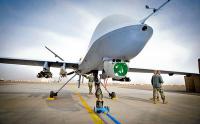-
Seeing through the dark clearly

A new device, dubbed Thermal on Demand (TOD), allows firefighters to see everything in a heavily smoke-filled room, where the unassisted eye sees nothing but a pitch-black environment. TOD allows responders to see doors, furniture, light switches, debris on the floor, and victims lying on the floor. Looking through a periscopic lens, in front of a thermal camera, the wearer sees a detailed image of everything in the immediate vicinity.
-
-
Criminals acquire guns through social connections, not through theft or dirty dealers
Criminals are far more likely to acquire guns from family and acquaintances than by theft, according to two new studies. “There are a number of myths about how criminals get their guns, such as most of them are stolen or come from dirty dealers. We didn’t find that to be the case,” says one of the researchers.
-
-
Beyond data theft: Next phase of cyber intrusions will include destruction, manipulation of data
James Clapper, director of U.S. intelligence, and other senior intelligence officers, have warned Congress that the next phase of escalating online data theft will likely involve the manipulation of digital information. Clapper on Wednesday told lawmakers on the House Intelligence Committee that a “cyber Armageddon,” in which a digitally triggered damage to physical infrastructure results in a series of catastrophic events, is less likely than “cyber operations that will change or manipulate data.” Leaders of the U.S. intelligence community told lawmakers that the manipulation or destruction of data would undermine confidence in data stored on or accessible through U.S. networks, engendering an uncertainty which could jeopardize U.S. military situational awareness and undermine business activity.
-
-
UN inquiry to determine who is responsible for chemical attacks in Syria
Russia has withdrawn its objections to a UN investigation into identifying the culprits responsible for chemical attacks in Syria, allowing a probe to begin, UN diplomats said Thursday. For the last two years, Russia had insisted that a series of UN investigative teams sent to Syria would be limited to finding out whether or not chemical weapons had been used, but would be barred from identifying who was responsible for launching them.
-
-
Two states changes gun laws, and suicide-by-firearm rates in the two states shift

A new study examining changes in gun policy in two states finds that handgun purchaser licensing requirements influence suicide rates. Researchers estimate that Connecticut’s 1995 law requiring individuals to obtain a permit or license to purchase a handgun after passing a background check was associated with a 15.4 percent reduction in firearm suicide rates, while Missouri’s repeal of its handgun purchaser licensing law in 2007 was associated with a 16.1 percent increase in firearm suicide rates.
-
-
Russian-American admits to smuggling sensitive weapon tech to Russia
Alexander Fishenko, 49, a Russian-American businessman, pleaded guilty yesterday (Wednesday) to charges of smuggling sensitive U.S. microelectronics to Russia. He was arrested in 2012 on allegations that he had shipped export-controlled electronics and computer chips which are used in radar and surveillance systems, missile guidance systems, and detonation triggers.
-
-
Engineers design invisibility cloak for military drones
Inspired by the well-known Invisibility Cloak from Harry Potter, electrical engineers have created a new design for their cloaking device, using a Teflon substrate, studded with cylinders of ceramic, which is thinner than any prior development and does not alter the brightness of light around concealed objects. The Teflon has a low refractive index, while the ceramic’s refractive index is higher, which allows light to be dispersed through the sheet without any absorption. Compared to an invisibility cloak, this technology has not only the ability to conceal, but the ability to increase optical communication signal speed and to collect solar energy.
-
-
Upholding disarmament agreements with engineering
Arms control agreements face a problem: how to ensure that countries with nuclear weapons abide by disarmament agreements. The linchpin of these agreements is being able to verify that the signers are following the rules — but the trick is for both sides, or a third party, to be able to police weapons in a way that doesn’t give out too much information about them, for example, how these weapons were built. An MIT project, called Zero Knowledge Warhead Verification, tackles this problem with a beam of light, a scrambler, and a detector.
-
-
Data show drone attacks doomed to fail against ISIS in Syria

This week, the Washington Post published a story about a new U.S. plan to use lethal drone strikes in Syria to destroy ISIS capabilities on the ground. The desire to do something — anything — to destroy the capabilities of a group so luridly destructive is understandable, but our haste to show results will likely result in a hollow victory at best. But there is a problem: there’s no evidence that drone strikes work. On the contrary, ample evidence shows drone strikes have not made Americans safer or reduced the overall level of terrorist capability. The strikes amount to little more than a waste of life, political capital, and resources. Drones cannot deliver victory over ISIS, but in any event, lacking a cohesive, articulate political strategy for governance and post-ISIS reconstruction, no military solution can produce the results we’re looking for. Lacking the political strategy, more of the same in Syria promises no better.
-
-
New personality profiling technique helps identify potential school shooters
Researchers from Ben-Gurion University of the Negev (BGU) have developed a personality profiling technique which automates the identification of potential school shooters by analyzing personality traits that appear in their writings. The text-based computational personality-profiling tool uses “vector semantics.” This involves constructing a number of vectors representing personality dimensions and disorders, which are analyzed automatically by computer to measure the similarity with texts written by the human subject.
-
-
Apple's encryption prevents it from complying with U.S. court order
Apple said it could not comply with a court order to hand over texts sent using iMessage between two iPhones because the company’s encryption system makes it impossible to do so. The Justice Department persuaded the court to issue the order to facilitate an investigation involving guns and drugs. Legal experts say this is the first known direct face-off between the U.S. government and Apple over encryption. The FBI contends that such encryption puts the American public at risk because it makes it harder, if not impossible, to track and catch terrorists, pedophiles, and other criminals.
-
-
How Western Europe came to dominate the globe

Although Europe represents only about 8 percent of the planet’s landmass, from 1492 to 1914, Europeans conquered or colonized more than 80 percent of the entire world. There are many possible explanations for why history played out this way, but few can explain why the West was so powerful for so long. Caltech’s Philip Hoffman, a professor of business economics and history, has a new explanation: the advancement of gunpowder technology. The Chinese invented gunpowder, but Hoffman argues that certain political and economic circumstances allowed the Europeans to advance gunpowder technology at an unprecedented rate — allowing a relatively small number of people quickly to take over much of the rest of the globe. What lessons does his explanation of the West’s rise to dominance offer for today’s policy makers? “In a world where there are hostile powers, we really don’t want to get rid of spending on improving military technology,” Hoffman says. “I would much rather see expenditures devoted to infrastructure, or scientific research, or free preschool for everybody – things that would carry big economic benefits,” and “I wish we did live in that world, but unfortunately it’s not realistic.”
-
-
Determining the age of fingerprints
Watch the imprint of a tire track in soft mud, and it will slowly blur, the ridges of the pattern gradually flowing into the valleys. Researchers have tested the theory that a similar effect could be used to give forensic scientists something they’ve long wished for: A way to date fingerprints. Even the approximate age of a fingerprint can have a critical bearing on forensic results, as it can rule out some prints as being too old to be relevant to a crime scene. Military forensics experts would like to be able to date the multitude of fingerprints found on improvised bombs used by insurgents to winnow out prints of individuals who may simply have handled the components in a shop from those of the actual bombmakers.
-
-
The number of guns stolen from police officers is growing
From time to time, the media report of a burglary in which a firearm was stolen. Some of those stolen weapons were later used in the commission of crime, oftentimes a robbery or shooting. In the past few years, however, a trend has been developed, but which has not been reported in the mass media. That occurrence is the theft of a police officer’s firearm, often accompanied by the pilfering of the officer’s uniform, vest, and badge.
-
-
Prepaid card reader helps law enforcement in seizing fraudulent cards
During arrests of criminal couriers, law enforcement officers rarely find bundles of cash wrapped in rubber bands anymore. Instead, they find stacks of plastic cards — bank credit and debit cards, retail gift cards, library cards, hotel card keys, even magnetic-striped Metrorail cards — which have been turned into prepaid cards. DHS S&T’s Electronic Recovery and Access to Data (ERAD) Prepaid Card Reader is a small, handheld device which uses wireless connectivity to allow law enforcement officers in the field to check the balance of cards. This allows for identification of suspicious prepaid cards and the ability to put a temporary hold on the linked funds until a full investigation can be completed.
-
More headlines
The long view
Tantalizing Method to Study Cyberdeterrence
Tantalus is unlike most war games because it is experimental instead of experiential — the immersive game differs by overlapping scientific rigor and quantitative assessment methods with the experimental sciences, and experimental war gaming provides insightful data for real-world cyberattacks.
Using Drone Swarms to Fight Forest Fires
Forest fires are becoming increasingly catastrophic across the world, accelerated by climate change. Researchers are using multiple swarms of drones to tackle natural disasters like forest fires.
Testing Cutting-Edge Counter-Drone Technology
Drones have many positive applications, bad actors can use them for nefarious purposes. Two recent field demonstrations brought government, academia, and industry together to evaluate innovative counter-unmanned aircraft systems.
European Arms Imports Nearly Double, U.S. and French Exports Rise, and Russian Exports Fall Sharply
States in Europe almost doubled their imports of major arms (+94 per cent) between 2014–18 and 2019–23. The United States increased its arms exports by 17 per cent between 2014–18 and 2019–23, while Russia’s arms exports halved. Russia was for the first time the third largest arms exporter, falling just behind France.
How Climate Change Will Affect Conflict and U.S. Military Operations
“People talk about climate change as a threat multiplier,” said Karen Sudkamp, an associate director of the Infrastructure, Immigration, and Security Operations Program within the RAND Homeland Security Research Division. “But at what point do we need to start talking about the threat multiplier actually becoming a significant threat all its own?”
The Tech Apocalypse Panic is Driven by AI Boosters, Military Tacticians, and Movies
From popular films like a War Games or The Terminator to a U.S. State Department-commissioned report on the security risk of weaponized AI, there has been a tremendous amount of hand wringing and nervousness about how so-called artificial intelligence might end up destroying the world. There is one easy way to avoid a lot of this and prevent a self-inflicted doomsday: don’t give computers the capability to launch devastating weapons.
